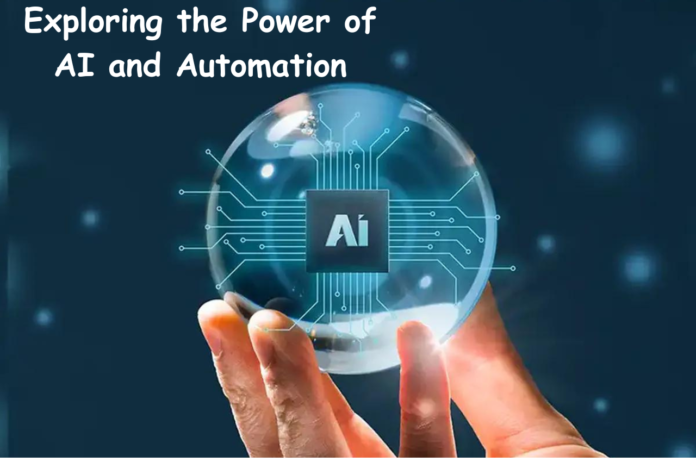Do you want to get lost in exploring the power of AI and Automation? Then you are in the right place. In an era of rapid technological evolution, the integration of artificial intelligence (AI) and automation is poised to usher in a new era that redefines the way we work, live and innovate. Today’s article explores the transformative potential of AI and automation, examining their collaborative power and the profound impact they can have on various industrial and social structures. As automation increasingly becomes synonymous with progress, this essay aims to unravel the complexities of this technological convergence and its implications for the future.
Thank you for reading this post, don't forget to subscribe!AI and Automation in the Workplace
The integration of artificial intelligence (AI) and automation technologies in the workplace has become a focal point in recent times. Scholars such as Brynjolfsson and McAfee (2014) have highlighted the potential of these technologies to achieve significant productivity gains by automating routine tasks, allowing human workers to focus on more complex and creative endeavors.
AI and automation technologies can perform tasks much faster and with greater accuracy than humans in many cases. This boosts productivity and efficiency across various sectors, from manufacturing to service industries. AI systems are capable of analyzing vast amounts of data and making decisions based on patterns and algorithms. This leads to more accurate predictions and insights, which can help businesses make better-informed decisions.
Automation can be particularly beneficial in hazardous or physically demanding work environments, where the risk of injury to human workers is high. Robots and AI-driven systems can perform these tasks with precision and without putting human lives at risk. AI and automation are not necessarily about replacing humans entirely but augmenting their capabilities. Collaborative robots (cobots) work alongside humans in many industries, increasing efficiency and productivity while maintaining human oversight and decision-making.
However, concerns about job displacement and the need to upskill the workforce are recurring themes, requiring a nuanced understanding of the social implications.
Efficiency Gains and Workflow Optimization
Efficiency gains through workflow optimization are prominent themes in studies by Arntz et al. (2016) and Manyika et al. (2017). They emphasize how AI and automation can streamline processes, reduce operational costs, and enhance overall organizational efficiency. The literature underscores the importance of not only automating existing workflows but also reimagining processes to fully harness the potential of these technologies.
Innovation and Economic Growth
AI and automation are recognized as catalysts for innovation and economic growth. Autor (2015) argues that automation, when complemented by human skills, can lead to the creation of new industries and job categories. The literature emphasizes the need for proactive policies to foster innovation, entrepreneurship, and the integration of advanced technologies to propel economic growth in the long term.
Case Studies: Real-World Applications
Several case studies provide valuable insights into the real-world applications of AI and automation. For instance, the implementation of robotic process automation (RPA) at a leading financial institution, as detailed by Smith et al. (2019), showcases tangible efficiency gains and cost savings. These case studies serve as practical examples of successful integration strategies and highlight the adaptability of AI and automation across diverse industries.
Social Impacts and Ethical Considerations
Articles addressing the societal implications of AI and automation fall into critical issues. Frey and Osborne (2017) discuss the potential for job displacement, particularly in routine and manual tasks, and advocate for proactive measures such as education and retraining programs. The ethical considerations surrounding AI and automation, including bias in algorithms and privacy concerns, are addressed by Diakopoulos (2016) and Floridi et al (2018), emphasizing the importance of responsible development and deployment.
Emerging Trends and Future Directions
Recent studies explore emerging trends and future directions in AI and automation. The study by Chui et al. (2020) and Lee et al. (2021) highlight the growing importance of human-machine collaboration, with AI augmenting human capabilities rather than completely replacing them. Additionally, the literature suggests that the convergence of AI with other emerging technologies, such as the Internet of Things (IoT) and edge computing, will shape the future landscape of automation.
Conclusion
In conclusion, the results and discussions affirm the transformative power of AI and automation in reshaping industries, workflows, and societal structures. The efficiency gains, innovation, and economic growth facilitated by these technologies underscore their potential to drive positive change. However, the discussion also emphasizes the importance of addressing societal impacts and ethical considerations to ensure a balanced and responsible integration. As organizations navigate the path of automation, the collaborative approach of human-machine interaction emerges as a key theme, heralding a future where the combined capabilities of AI and human intelligence unlock unprecedented possibilities. Today’s talk on Technocommy’s exploration of the power of AI and automation will delve into real-world applications and case studies, providing concrete examples that further illustrate the potential and challenges of future automation.


